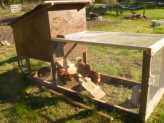Egg Hatching Troubleshooting Guide
For when it all goes horribly wrong...
This Egg Hatching Troubleshooting Guide will help you determine possible causes of your incubation problems and some solutions.
Chicken eggs of all breeds including Bantams should take 21 days of incubation to hatch.
In some cases, the same batch of eggs split between a hen for part of the hatch and the remaining amount in the incubator there can be up to one full day of difference.
Eggs hatched under a hen sometimes hatch first. If they take longer or shorter time, here are a few reasons why:
Egg Hatching Troubleshooting Guide:
|
Symptoms |
Probable Causes
|
Suggestions
|
|
Many clear eggs. No blood (Determined by candling) |
1) Infertility.
|
1) Use strong vigorous males.
|
|
Slight blood rings |
3) Improper temperature.
|
3) Check accuracy of thermometer.
|
|
Many dead germs
|
5) Temperature too high or too
low.
|
5) See suggestions (3) above.
|
|
Pipped eggs not hatching.
|
10) Insufficient moisture.
|
10) Increase evaporating
surface.
|
|
Cripples and malpositions |
14) Temperature too high.
|
14) See (3) above and see "Note"
below.
|
|
Very large soft bodied weak
chicks,
|
18) Low average temperature.
|
18) See (3) above and see "Note"
below.
|
|
Rough navels. |
21) High temperature or wide
temperature variations.
|
21) See (3) above.
|
NOTE: If chicks hatch out a day early it indicates temperature was a little too high, so on next setting lower temperature by ½ degree F. for entire incubation period. If chicks hatch a day late, raise temperature ½ degree F. for entire incubation period.
In case of a power failure or incubator malfunction causing the eggs to get chilled, quick action is required to save the hatch. Immersing the eggs in warm water for a few minutes can quickly revive the chicks in the shell, depending on how long the eggs were chilled, and how far along in the incubation period the developing embryos are.
A thunderstorm as the chicks are incubating can kill them in the shell.
Try dowsing eggs before hatching them for a better percentage of pullets.
With careful adjustments, you can get around 60-90% hatching of your chicken eggs by following this Egg Hatching Troubleshooting Guide. You know what they say - don't count your chickens before they're hatched, and now you know where that saying comes from.

New! Comments
Have your say about what you just read! Leave me a comment in the box below.